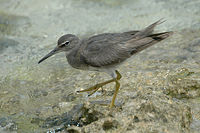
Wandering Tattler
Encyclopedia
The Wandering Tattler, Tringa incana (formerly Heteroscelus incanus: Pereira & Baker, 2005; Banks et al., 2006), is a medium-sized wading
bird. It is similar in appearance to the closely related Gray-tailed Tattler, T. brevipes. The tattlers are unique among the species of Tringa for having unpatterned, greyish wings and backs, and a scaly breast pattern extending more or less onto the belly in breeding plumage
, in which both also have a rather prominent supercilium
.
 These birds have stocky bodies with gray upperparts, underwings, face and neck and a white belly. They have short dark yellow legs and a dark gray bill
These birds have stocky bodies with gray upperparts, underwings, face and neck and a white belly. They have short dark yellow legs and a dark gray bill
. Adults in breeding plumage are heavily barred underneath.
In summer, they are found in Alaska
and northwestern Canada
. They nest in rocky areas along mountain streams. At other times, they are found on rocky islands in the southwest Pacific and on rocky Pacific coasts from California
to South America
and as far as Australia
.
They feed on aquatic invertebrates such as crustaceans and marine worm
s. During breeding season, they also eat insects. While wading, they forage
actively, making jerky bobbing movements.
The female lays 4 olive-colored eggs
in a shallow depression. Both parents incubate and help feed the young, who are soon able to forage for themselves.
The call is a rapid trill of accelerating, descending notes of decreasing volume.
Wader
Waders, called shorebirds in North America , are members of the order Charadriiformes, excluding the more marine web-footed seabird groups. The latter are the skuas , gulls , terns , skimmers , and auks...
bird. It is similar in appearance to the closely related Gray-tailed Tattler, T. brevipes. The tattlers are unique among the species of Tringa for having unpatterned, greyish wings and backs, and a scaly breast pattern extending more or less onto the belly in breeding plumage
Plumage
Plumage refers both to the layer of feathers that cover a bird and the pattern, colour, and arrangement of those feathers. The pattern and colours of plumage vary between species and subspecies and can also vary between different age classes, sexes, and season. Within species there can also be a...
, in which both also have a rather prominent supercilium
Supercilium
The supercilium is a plumage feature found on the heads of some bird species. It is a stripe which runs from the base of the bird's beak above its eye, finishing somewhere towards the rear of the bird's head. Also known as an "eyebrow", it is distinct from the eyestripe, which is a line which runs...
.

Beak
The beak, bill or rostrum is an external anatomical structure of birds which is used for eating and for grooming, manipulating objects, killing prey, fighting, probing for food, courtship and feeding young...
. Adults in breeding plumage are heavily barred underneath.
In summer, they are found in Alaska
Alaska
Alaska is the largest state in the United States by area. It is situated in the northwest extremity of the North American continent, with Canada to the east, the Arctic Ocean to the north, and the Pacific Ocean to the west and south, with Russia further west across the Bering Strait...
and northwestern Canada
Canada
Canada is a North American country consisting of ten provinces and three territories. Located in the northern part of the continent, it extends from the Atlantic Ocean in the east to the Pacific Ocean in the west, and northward into the Arctic Ocean...
. They nest in rocky areas along mountain streams. At other times, they are found on rocky islands in the southwest Pacific and on rocky Pacific coasts from California
California
California is a state located on the West Coast of the United States. It is by far the most populous U.S. state, and the third-largest by land area...
to South America
South America
South America is a continent situated in the Western Hemisphere, mostly in the Southern Hemisphere, with a relatively small portion in the Northern Hemisphere. The continent is also considered a subcontinent of the Americas. It is bordered on the west by the Pacific Ocean and on the north and east...
and as far as Australia
Australia
Australia , officially the Commonwealth of Australia, is a country in the Southern Hemisphere comprising the mainland of the Australian continent, the island of Tasmania, and numerous smaller islands in the Indian and Pacific Oceans. It is the world's sixth-largest country by total area...
.
They feed on aquatic invertebrates such as crustaceans and marine worm
Marine worm
Any worm that lives in a marine environment is considered a marine worm. Marine worms are found in several different phyla, including the Platyhelminthes, Nematoda, Annelida , Chaetognatha, Hemichordata, and Phoronida....
s. During breeding season, they also eat insects. While wading, they forage
Forage
Forage is plant material eaten by grazing livestock.Historically the term forage has meant only plants eaten by the animals directly as pasture, crop residue, or immature cereal crops, but it is also used more loosely to include similar plants cut for fodder and carried to the animals, especially...
actively, making jerky bobbing movements.
The female lays 4 olive-colored eggs
Bird egg
Bird eggs are laid by females and incubated for a time that varies according to the species; a single young hatches from each egg. Average clutch sizes range from one to about 17...
in a shallow depression. Both parents incubate and help feed the young, who are soon able to forage for themselves.
The call is a rapid trill of accelerating, descending notes of decreasing volume.

